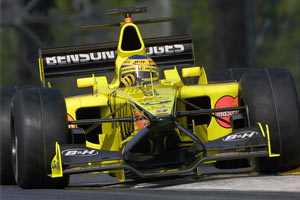Jordan EJ11 Honda

Active: 2001
Team: Jordan Grand Prix Ltd
Team: Eghbal Hamidy (TD), John Iley (CA), Tim Holloway (CD)
Drivers: Jarno Trulli (12/11), Heinz-Harald Frentzen (11), Ricardo Zonta (12), Jean Alesi (12)
Team name: Benson & Hedges Jordan Honda
After disappointment in 2000, Eddie Jordan announced ahead of the season that the team could not afford another such season. It was nevertheless going to be a difficult task as the team underwent a major reshuffle in management. Mike Gascoyne had left to join Benetton as early as May 2000. Other key technical personnel had also moved on, but to counter that, Eghbal Hamidy was signed by Jordan, even though the new technical director could only join the team at the start of the season.
The new car was set to iron out the reliability issues that plagued the 2000 campaign, taking a no-nonsense approach. This was also reflected at the car's launch in the Jordan GP headquarters at Silverstone on 16 January. Before that, the car was tested on 13 and 15 January and ran again on 17 January.
Team principal Eddie Jordan said at the launch: "We decided to can the development of the EJ10 quite early, in order to concentrate on the EJ11. Tim Holloway was given the responsibility of gelling all aspects of the new car together, and deserves a big thank-you for his efforts. It was a big responsibility, especially with a partner like Honda coming on board. I am delighted to say that, from February, Tim will be aided by Eghbal Hamidy, who joins us to set up a programme to ensure that continuity with this car and those in the future will be the best.
"We have restructured the management, added nearly 50 people ton the workforce and witnessed the team gel together into the most committed and dedicated team that Jordan has ever fielded. In facing the challenge of years ahead, we have had to grow the company in every direction. It hasn't been an easy task, but I have never felt so confident. We are a totally focused unit, looking forward to the tough, but exciting, times ahead."
Along with progress at the car itself, 2001 also marked a change of engines as Jordan began a partnership with Honda. Honda's F1 engine is an evolution of the powerful, reliable unit that powered British American Racing to fifth place in the 2000 season's constructors' championship, but many new elements have been incorporated in preparation for the two-pronged attack in 2001.
"The new engine may look the same from the outside, but we have improved the unit in almost every area," stressed Honda Racing Development technical director Kazutoshi Nishizawa, "We have investigated and addressed the issues from last season, and the result is a superior unit.
At the start of the season it became clear that the team had made considerable progress over the winter as Jarno Trulli and Heinz-Harald Frentzen delivered consistent point finishes in the first five races of the season.
After these races however, troubles arose, initially with lack of development on the car as the team had had much trouble resolving overheating problems during the winter testing - the team only got the new works Honda engine in early January. Later on, it appeared that 3 of the team's 450 component suppliers had faulty quality checks, resulting in repeated DNF's. This effectively rendered the exceptional qualifying efforts of Jarno Trulli useless.
All in all, the car was reasonably on the pace, mostly qualifying on the fourth row behind the top three teams, namely Ferrari, McLaren and Williams, sometimes even better. The lack of engine performance didn't help though, and as the electronics started to play a more extensive role, Jordan was hit harder than any other team. The in-house development of a new traction control system proved hard with the limited budget available. Competitors mostly chose for an outside of related supplier such as Pi or TAG.
Halfway through the season, Frentzen was then sacked for political reasons. His races did however prove solid and reliable but the German appeared to suffer from Trulli's qualifying dominance. At Hockenheim, test driver Ricardo Zonta filled in (as he did at Montreal when Frentzen was injured after a crash in free practice) until Alesi moved from Prost to complete the final 5 races of his F1 career.

Specifications
Chassis: Full carbon fibre composite monocoque.
Front suspension: Composite pushrods activating chassis mounted Penske dampers and torsion bars, unequal length aerodynamic wishbones, composite top and bottom wishbones, titanium fabricated uprights and front anti-roll bar.
Rear suspension: Composite pushrods activating gearbox mounted Penske dampers, unequal length aerodynamic wishbones, composite wishbones, titanium fabricated uprights and rear anti-roll bar.
Transmission: In-house Jordan Grand Prix design. 7 speed + reverse longitudinal gearbox with electrohydraulic sequential gear change.
Wheel base: Over 3000mm
Front track: 1500mm
Rear track: 1418mm
Overall height: 950mm
Overall length: 4650mm
Overall weight: 600kg with driver
Clutch: Triple plate Jordan/Sachs racing clutch
Wheels: Forged OZ Racing to Jordan GP specification
Fuel tank capacity: Over 100kg
Engine
Designation: Honda RA001E
Configuration: 3l 90° V10, normally aspirated
Brake horsepower: Over 800 hp
Cylinder heads: 4 Valves Per Cylinder Ð Pneumatic Valve System
Injection: Honda PGM Ð FI
Ignition: Honda PGM Ð IG
Spark plugs: NGK
RPM: Over 17,000 rpm
Throttle: Electro Hydraulic
Block: Aluminium

